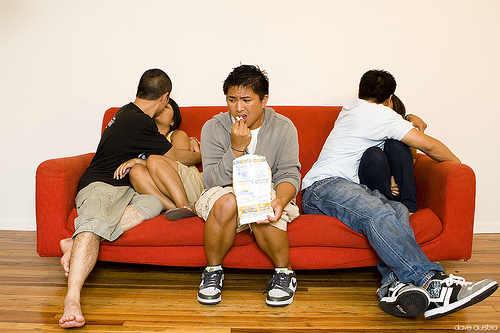In the realm of courtship, knowing how to play hard to get matters. A lot. I’ve heard many people tell me that when they have to work in order to get the attention or sexual availability of a member of the opposite sex, they enjoy it considerably more when they get it.
Like or not, we tend to subjectively perceive something more valuable if it was challenging to acquire than if it was just handed to us on a silver platter. And this pertains to male-female interactions as well.
Finding the Middle Ground
The problem concerning how to play hard to get is that many men and women go to an extreme and they do one of two things.
A) They do not play hard to get at all and they make themselves very easily available.
Now, to be clear, this doesn’t mean that members of the opposite sex still won’t like them. There are many traits beyond being a challenge that can make you attractive. However, learning how to play hard to get and doing this would really make them visibly more exciting.
B) They play hard to get too much, up to the point where they seem completely uninterested in the other person or totally inaccessible to them.
Thus, the other person will simply give up and stop pursuing them. Keep in mind that after all, this is called playing hard to get, not being hard to get. It’s all a fun little courtship game.
So, the trick is to find that middle ground. To behave in a way that makes you a challenge, but a surmountable one. That’s when you’re playing hard to get effectively.
It Starts With Your Attitude
The most important determinant by far of how well you can play hard to get is your attitude.
 As a confidence and communication coach, I’ve noticed that people who are very good at playing hard to get all have something in common regarding their attitude: they have a solid dose of social confidence.
As a confidence and communication coach, I’ve noticed that people who are very good at playing hard to get all have something in common regarding their attitude: they have a solid dose of social confidence.
This social confidence consists of several elements. First of all, they have a good self-image. They see themselves as likeable, attractive and worthy of the attention of men/women.
Second of all, they are willing to accept rejection and to risk the possibility that a person might sometimes be discouraged by the fact they pose a challenge. And last but not least, they’re not afraid to show their interest in somebody and they can also stop playing games when it’s fitting.
These forms of social confidence lead them to naturally behave in a way that makes getting them a fun challenge. They do it brilliantly well and they don’t even think about it.
Of course, you can try to just copy their behavior, and you will succeed to some extent, but it doesn’t work that well if you lack the inner social confidence.
Many times, you’ll miscalibrate those behaviors, or you’ll miss the subtleties in them and they’ll come off wrong when you use them. Plus, without the inner confidence, you’ll never internalize them and they won’t ever feel natural to you.
This is why I often say that the best way to learn how to play hard to get is to build your social confidence. Develop the attitude of people who are good at playing hard to get, and you’ll naturally become good as well.
With this in mind, I invite you to check out my special presentation on building social confidence. In it I will show you exactly where social confidence comes from, and what are the two simple, scientifically supported steps for improving it. Go here and watch it.
5 Ways to Play Hard To Get
Beyond working on the attitude part, there are some specific behaviors you can practice when dealing with persons of the opposite sex in order to successfully play hard to get. Here are the top 5 such behaviors that I’ve indentified as creating the very best results.
1) Giving double-sided compliments. A double-sided compliment is a positive remark about the other person, but which also contains an implicit joke or negative remark about them. For example: “You’re pretty cute for a short girl”.
In this case, calling the girl cute is a compliment, but the overall remark also implies that in general you don’t find short girls (which she is) cute. Double-sided compliments are a great way to convey interest, but in a cocky, non-needy way.
2) Taking rain checks. When somebody you like asks you out or to do something with them at a certain date and time, politely say to them that you can’t at that suggested moment because you have others plans, but that you’ll gladly do it some other time.
The key is to decline the invitation, but only for the proposed date and time. If you just decline it, they might think you’re simply not interested in them. You want to show availability and lack of availability at the same time.
3) Dividing your attention. When you’re in a group setting and there is a person you like in that group, pay attention to them, talk to them, but pay attention to the other members of the group as well, especially the ones of the opposite gender.
Do give this person attention but don’t give them your whole attention. Give them some attention, then take it away and refocus it, then give them some more, then take it away again.
4) Not showing too much interest too early. It’s rarely a good idea to convey to a member of the opposite sex, verbally or non-verbally, that you’re totally enthralled with them the very first moment you lay eyes on them.
A person with a good self-image and a lot of options in their life is not impressed that easily. Don’t try to hide that they caught your eye and you want to get to know them better. But don’t convey a ton of interest right off the bat either.
5) Not being in a hurry to get into a relationship. For a person who is confident and independent, there is nothing more off putting then to simply make out with some girl/guy at a party and have them immediately start treating you as if you’re their boyfriend/girlfriend: calling you non-stop, wanting to hang out all the time, visiting you and not leaving anymore, etc.
Take your time. Don’t be in a rush to make somebody your significant other and don’t suffocate them with your attention. Get to know them better, experiment, have fun, and let the relationship build up gradually.
As you employ these behaviors, bear in mind that in learning how to play hard to get, you’ll make much more progress from changing your attitude along with your behavior than by changing your behavior alone.
Again, I encourage you to watch this presentation on becoming socially confident.
Your behavior will always be inclined to reflect your inner attitude. And there is only so much that you can play hard to get if it doesn’t come from within. But if it does come from within (and you can make it so), it will change the way others react to you entirely.
Image courtesy of jonaldinger

 Attending events that are social in nature: parties, classes, networking events, etc.
Attending events that are social in nature: parties, classes, networking events, etc. I know that you may want to find a way to not be socially inept anymore and afterwards go out and socialize, but unfortunately, it doesn’t really work that way. It works the other way around.
I know that you may want to find a way to not be socially inept anymore and afterwards go out and socialize, but unfortunately, it doesn’t really work that way. It works the other way around. If you’re shy and interested in finding a job, you may be wondering: What are some good jobs for shy people?
If you’re shy and interested in finding a job, you may be wondering: What are some good jobs for shy people? Many shy and socially anxious people are interested in learning how to be more talkative. Some people seem to naturally be talkative and connect easy with others. They on the other hand struggle with this.
Many shy and socially anxious people are interested in learning how to be more talkative. Some people seem to naturally be talkative and connect easy with others. They on the other hand struggle with this. So, you want to learn how to be witty? I understand you perfectly. The witty person in a social setting is the person who gets all the attention, makes everyone laugh, is liked by everybody and has no problems connecting with others.
So, you want to learn how to be witty? I understand you perfectly. The witty person in a social setting is the person who gets all the attention, makes everyone laugh, is liked by everybody and has no problems connecting with others. A conversation is basically an exchange of information on various topics between two or more people. When the content and form of the conversation are appropriate, people connect with each other. Having good things to talk about plays a big role here.
A conversation is basically an exchange of information on various topics between two or more people. When the content and form of the conversation are appropriate, people connect with each other. Having good things to talk about plays a big role here. 6. The lack of meaningful connections with others. Since they struggle with making conversation, feeling at ease around others and expressing themselves effectively, socially awkward people typically lack strong connections with others.
6. The lack of meaningful connections with others. Since they struggle with making conversation, feeling at ease around others and expressing themselves effectively, socially awkward people typically lack strong connections with others.